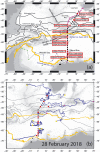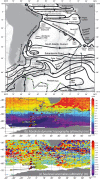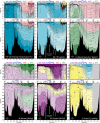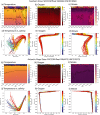Southern Ocean Biogeochemical Float Deployment Strategy, With Example From the Greenwich Meridian Line (GO-SHIP A12)
- PMID: 31007997
- PMCID: PMC6472510
- DOI: 10.1029/2018JC014059
Southern Ocean Biogeochemical Float Deployment Strategy, With Example From the Greenwich Meridian Line (GO-SHIP A12)
Abstract
Biogeochemical Argo floats, profiling to 2,000-m depth, are being deployed throughout the Southern Ocean by the Southern Ocean Carbon and Climate Observations and Modeling program (SOCCOM). The goal is 200 floats by 2020, to provide the first full set of annual cycles of carbon, oxygen, nitrate, and optical properties across multiple oceanographic regimes. Building from no prior coverage to a sparse array, deployments are based on prior knowledge of water mass properties, mean frontal locations, mean circulation and eddy variability, winds, air-sea heat/freshwater/carbon exchange, prior Argo trajectories, and float simulations in the Southern Ocean State Estimate and Hybrid Coordinate Ocean Model (HYCOM). Twelve floats deployed from the 2014-2015 Polarstern cruise from South Africa to Antarctica are used as a test case to evaluate the deployment strategy adopted for SOCCOM's 20 deployment cruises and 126 floats to date. After several years, these floats continue to represent the deployment zones targeted in advance: (1) Weddell Gyre sea ice zone, observing the Antarctic Slope Front, and a decadally-rare polynya over Maud Rise; (2) Antarctic Circumpolar Current (ACC) including the topographically steered Southern Zone chimney where upwelling carbon/nutrient-rich deep waters produce surprisingly large carbon dioxide outgassing; (3) Subantarctic and Subtropical zones between the ACC and Africa; and (4) Cape Basin. Argo floats and eddy-resolving HYCOM simulations were the best predictors of individual SOCCOM float pathways, with uncertainty after 2 years of order 1,000 km in the sea ice zone and more than double that in and north of the ACC.
Keywords: Southern Ocean; biogeochemical floats; carbon cycle; circulation; sea ice; water masses.
Figures







Similar articles
-
Effects of Mesoscale Eddies on Southern Ocean Biogeochemistry.AGU Adv. 2024 Dec;5(6):e2024AV001355. doi: 10.1029/2024AV001355. Epub 2024 Nov 30. AGU Adv. 2024. PMID: 39619278 Free PMC article.
-
Reassessing Southern Ocean Air-Sea CO2 Flux Estimates With the Addition of Biogeochemical Float Observations.Global Biogeochem Cycles. 2019 Nov;33(11):1370-1388. doi: 10.1029/2019GB006176. Epub 2019 Nov 16. Global Biogeochem Cycles. 2019. PMID: 32025087 Free PMC article.
-
Twenty years of ocean observations with China Argo.Hai Yang Xue Bao. 2023;42(2):1-16. doi: 10.1007/s13131-022-2076-3. Epub 2023 Mar 16. Hai Yang Xue Bao. 2023. PMID: 36941976 Free PMC article. Review.
-
Open-ocean polynyas and deep convection in the Southern Ocean.Sci Rep. 2019 May 6;9(1):6935. doi: 10.1038/s41598-019-43466-2. Sci Rep. 2019. PMID: 31061471 Free PMC article.
-
Observing the Global Ocean with Biogeochemical-Argo.Ann Rev Mar Sci. 2020 Jan 3;12:23-48. doi: 10.1146/annurev-marine-010419-010956. Epub 2019 Aug 21. Ann Rev Mar Sci. 2020. PMID: 31433959 Review.
Cited by
-
Direct observational evidence of strong CO2 uptake in the Southern Ocean.Sci Adv. 2024 Jul 26;10(30):eadn5781. doi: 10.1126/sciadv.adn5781. Epub 2024 Jul 24. Sci Adv. 2024. PMID: 39047102 Free PMC article.
-
Effects of Mesoscale Eddies on Southern Ocean Biogeochemistry.AGU Adv. 2024 Dec;5(6):e2024AV001355. doi: 10.1029/2024AV001355. Epub 2024 Nov 30. AGU Adv. 2024. PMID: 39619278 Free PMC article.
-
Observing Changes in Ocean Carbonate Chemistry: Our Autonomous Future.Curr Clim Change Rep. 2019;5(3):207-220. doi: 10.1007/s40641-019-00129-8. Epub 2019 May 7. Curr Clim Change Rep. 2019. PMID: 31404217 Free PMC article. Review.
-
Intense ocean freshening from melting glacier around the Antarctica during early twenty-first century.Sci Rep. 2022 Jan 10;12(1):383. doi: 10.1038/s41598-021-04231-6. Sci Rep. 2022. PMID: 35013425 Free PMC article.
-
Antarctic offshore polynyas linked to Southern Hemisphere climate anomalies.Nature. 2019 Jun;570(7761):319-325. doi: 10.1038/s41586-019-1294-0. Epub 2019 Jun 10. Nature. 2019. PMID: 31182856
References
-
- Abernathey, R. P. , Cerovecki, I. , Holland, P. , Newsom, E. , Mazloff, M. , & Talley, L. D. (2016). Water mass transformation by sea ice in the upper branch of the Southern Ocean overturning. Nature Geoscience, 9, 596–601. 10.1038/ngeo2749 - DOI
-
- Ardyna, M. , Claustre, H. , Sallée, J.‐B. , D'Ovidio, F. , Gentili, B. , van Dijken, G. , et al. (2017). Delineating environmental control of phytoplankton biomass and phenology in the Southern Ocean. Geophysical Research Letters, 44, 5016–5024. 10.1002/2016GL072428 - DOI
-
- Arteaga, L. , Haëntjens, N. , Boss, E. , Johnson, K. S. , & Sarmiento, J. L. (2018). Assessment of export efficiency equations in the southern ocean applied to satellite‐based net primary production. Journal of Geophysical Research: Oceans, 123, 2945–2964. 10.1002/2018JC013787 - DOI
-
- Bakker, D. C. E. , Hoppema, M. , Schroder, M. , Geibert, W. , & deBaar H. J. W. (2008). A rapid transition from ice covered CO2‐rich waters to a biologically mediated CO2 sink in the eastern Weddell Gyre. Biogeosciences, 5, 1373–1386. 10.5194/bg-5-1373-2008 - DOI
-
- Balch, W. M. , Drapeau, D. T. , Bowler, B. C. , Lyczskowski, E. , Booth, E. S. , & Alley, D. (2011). The contribution of coccolithophores to the optical and inorganic carbon budgets during the Southern Ocean Gas Exchange Experiment: New evidence in support of the “Great Calcite Belt” hypothesis. Journal of Geophysical Research, 116, C00F06 10.1029/2011JC006941 - DOI
